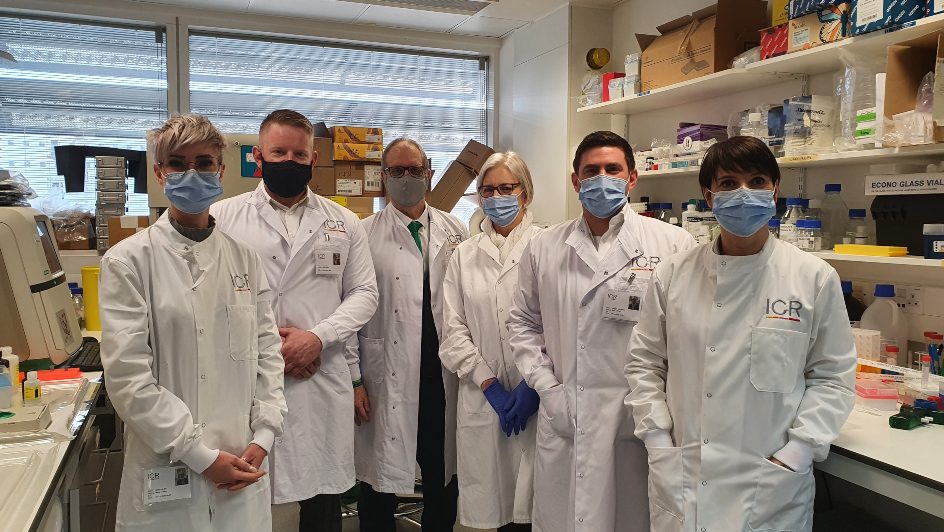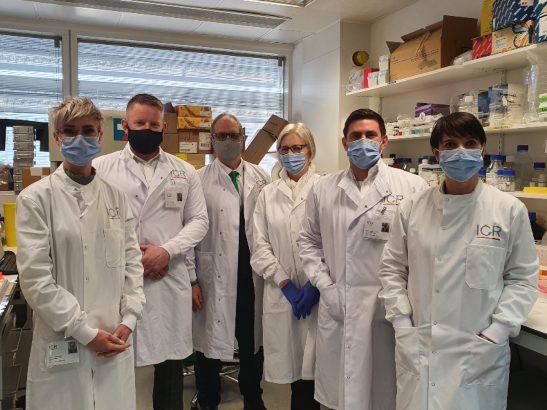
Team Luke visited Dr Chiara Gorrini in the lab to hear more about the research they're generously supporting.
“There’s a huge knowledge gap when it comes to childhood cancers and this really struck me after moving from a breast cancer lab. Childhood cancers are so diverse, and we really need to unravel their underlying biology, so that we can develop better treatments.”
After ten years in Canada studying the deep biology of breast cancer, Dr Gorrini has joined Professor Louis Chesler’s lab at The Institute of Cancer Research, London. She is focused on two types of childhood cancer, neuroblastoma, a type of cancer that develops in nerve tissues, and medulloblastoma, a type of brain tumour.
“New technologies, are allowing us to study childhood cancers in more detail than ever before and it’s a really exciting time to be joining the ICR.”
Dr Gorrini brings years of experience developing the latest technologies to improve the way we study cancer – developing highly specialised mouse models and improving state-of-the-art imaging technologies, which can track cancer in unprecedented detail.
Dr Gorrini said: “I started approaching these technologies in my breast cancer lab in Canada which worked closely with the engineering faculty. It’s really exciting to join a lab that’s using these techniques for childhood cancer.”
We are an internationally leading research centre in the study of cancers in children, teenagers and young adults. Find out more about our research in this field.
Taking on the challenges of childhood cancer
In the UK, around 100 children are diagnosed with neuroblastoma and 55 children are diagnosed with medulloblastoma each year. Compared to more common cancers, the relatively small number of cases presents major challenges for studying the disease. It can be difficult to gather statistical power in experiments and draw meaningful conclusions.
New technologies, which make it possible to study less common cancers in detail, without the need for thousands of tissue samples are proving invaluable. Dr Gorrini will now work to improve the models available for studying these childhood cancers, in order to accelerate the development of new treatments.
'Spot cancer's weaknesses'
“The models and imaging technology we use to study cancer allow us to look at the most comprehensive picture of the tumours in real-time, with the hope that we can spot cancer’s weaknesses,” she said.
“Ideally, you want to have a marker that allows you to track every cell type, and even the status of that cell type, for example, is it proliferating? Is it dying? Is it activated, aggressive, not aggressive? We’re working to improve this.”
Dr Gorrini is also using these models to better understand cancer evolution – that is, the ability of cancer to change and evolve resistance to treatment. It’s one of the biggest challenges in cancer research, and the major reason why drugs often stop working, or why patients relapse after treatment.
“Tracking how cells change within tumours is a vital tool for understanding cancer evolution. We’re trying to find ways to stop any changes that might mean cancer progresses or becomes resistant to treatment.
Our Centre for Cancer Drug Discovery hosts the world’s first ‘Darwinian’ drug discovery programme, designed to tackle cancer’s lethal ability to evolve resistance to treatment. We need your support to continue to fund the exciting work taking place there.
Cancers and the immune system
The team are also particularly interested in studying the interplay between cancers and the immune system.
Dr Gorrini said: “The number and type of immune cells within a tumour can also dictate whether it will progress or respond to treatment. I realised that this area of research is still largely unexplored in paediatric cancers, as compared to breast cancer, for example. With the discovery and approval of immunotherapies in the clinic, we really need to fill this gap of knowledge so that in future, children with cancer can benefit.”
Dr Gorrini feels a deep and personal connection to her research.
“Much like I was motivated in breast cancer research by my shared experience with other women – in childhood cancer, I think my experience as a mum helps to drive me. I feel a mix of anger and determination to make things better for these kids. You see what they are going through – intensive, exhausting treatments, and feel an urge to protect them. It becomes very personal.”
Dr Gorrini’s post is being supported by the TeamLuke Foundation, which was set up as a legacy for Luke Bell, who passed away from neuroblastoma at just eight years old.
The Foundation has pledged an incredible £15,000 per year towards Chiara’s post as Senior Staff Scientist in Professor Chesler’s team. The post contributes a huge amount to help the team translate scientific discoveries into benefits for patients and improve the outlook for children with cancer, in Luke’s name and memory.
We are very grateful to have the support of family charity partners, who have been tuched by cancer themselves and drive our research forward immeasurably. Read more about family charity partners.
Supporting improvements in diagnosis and treatment
Luke’s dad Mark says: “TeamLuke Foundation are incredibly proud to be supporting Dr Chiara Gorrini in her research work at the Institute of Cancer Research. As a family, watching Luke battle High Risk Neuroblastoma was the hardest thing we have ever had to do but it gave us the strength & motivation to help other families in similar situations by supporting improvements in the diagnosis and treatment of this awful disease.
Luke was a very inquisitive boy and loved helping other people. These qualities are at the heart of his legacy. They are also qualities we recognise in the ICR and we are both pleased and excited to have formed this partnership.”
Dr Gorrini said: “I am in awe of the family charity partners, including the TeamLuke Foundation. Their incredible support fuels our research and I hope it will enable us to make the next breakthroughs for children with cancer.
“Working in childhood cancer can be scary sometimes, but I feel honoured to be part of this challenge. It feels like the right place and right time to join the lab and make progress.”
